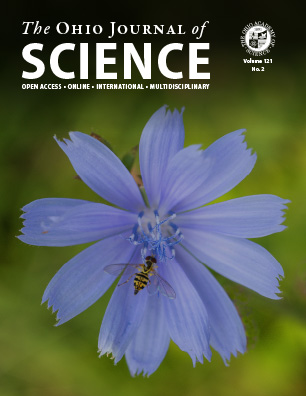Effects of Short-Term Exposure to Diesel Exhaust on the Ecophysiology, Growth, and Fecundity of Soybean (Glycine max (L.) Merr.) and Chicory (Cichorium intybus L.)
DOI:
https://doi.org/10.18061/ojs.v121i2.6936Keywords:
diesel exhaust, particulate matter, photosynthetic rate, stomatal conductance, water use efficiencyAbstract
Plants growing along roadways are often exposed to vehicle exhaust containing both particulate matter (PM) and various gases that could affect gas exchange and thus plant reproduction. To investigate effects of diesel exhaust exposure on plant ecophysiology, growth, and fecundity, individuals of soybean (Glycine max (L.) Merr.) and chicory (Cichorium intybus L.) were exposed to either exhaust from a diesel generator or ambient air. Exposure occurred daily over a 5-day period (beginning 18 June 2013) using open-top chambers in an agricultural field in southwestern Ohio, United States. Plants were evaluated at 3 times (before, directly after exposure, and following a 5.5-week post-treatment recovery period) for photosynthetic rate (A), stomatal conductance (g), water use efficiency (WUE), stomatal clogging due to PM deposition, and number of nodes. Aboveground biomass, fruit number, mean seed number, and seed mass were measured for soybean after the recovery period. In soybean, A minimally decreased with exposure to diesel exhaust (compared to the control), but an increase in g and a decrease in WUE were detected after the exhaust treatment. Chicory exhibited a relatively low increase in A after the treatment, but there were no clear differences in g or WUE. Growth and fecundity were similar among all soybean plants directly after treatment, but after 5.5 weeks plants exposed to diesel exhaust had increased vegetative biomass while exhibiting no difference in fecundity. These plant species reacted differently to short-term diesel exhaust exposure, suggesting that the impact of diesel exhaust will depend on both the plant species and its physiology.
Downloads
Published
Issue
Section
License
Copyright (c) 2021 Susan Y. Jaconis; Theresa M. Culley; Timothy Keener; Alexandra M. Odom; Robert Elam; Marissa S. Liang

This work is licensed under a Creative Commons Attribution 4.0 International License.

